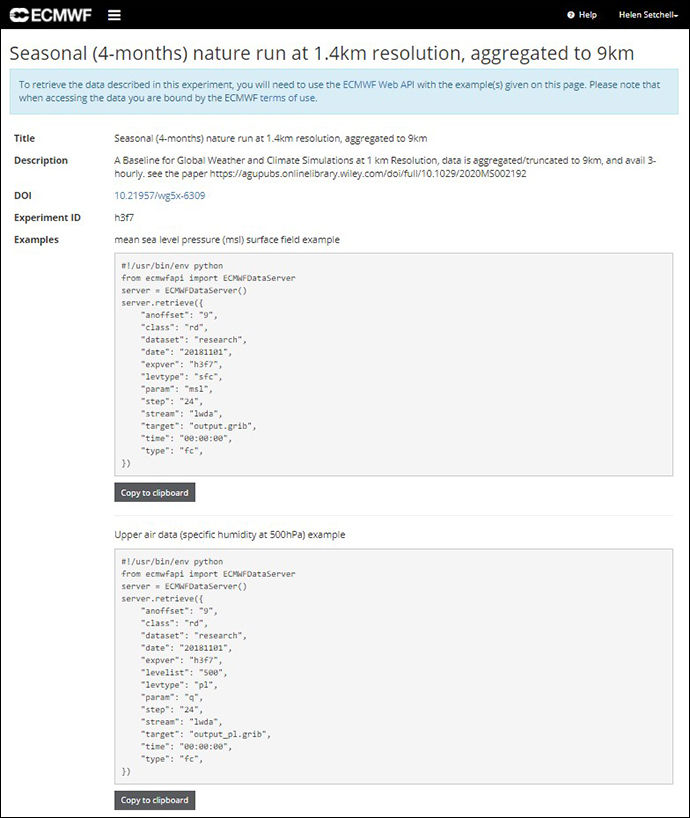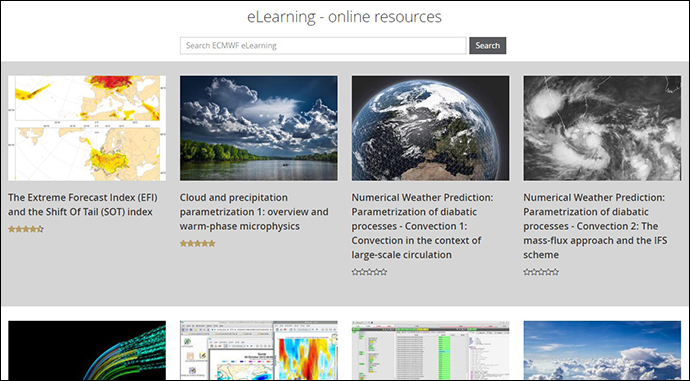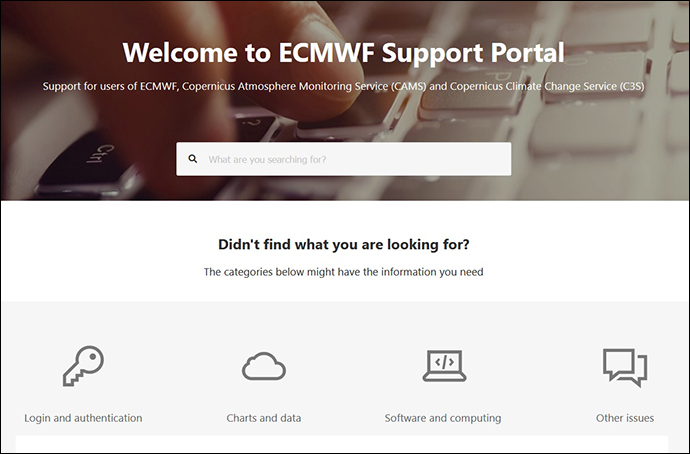The web enables global collaborative efforts to advance numerical weather prediction and gives us the ability to disseminate our products. We are committed to continuously developing and improving the ECMWF web, our online interface with the world. The aim is to support ECMWF’s Strategy and respond to changes in technology and the behaviours and needs of our users. By building an ECMWF web which is useful and usable, we provide a place where an online community of empowered users can collaborate and share knowledge. Through user-friendly and intuitive online interfaces, they help themselves to make effective use of ECMWF products and services.
Since our last update on web developments at ECMWF (Setchell, 2018), we have significantly updated those areas of our web which bring most value and are most used. We have made our real-time charts freely available with an open licence (CC-BY-4.0) through a new and improved chart browser, and we have improved the performance of our interactive online charts, ‘ecCharts’. Users can also expect to see on-demand plotting for observation statistics in the future. For those wanting to experiment with data, we have created new online ‘hubs’. We have also begun work on a new data browser to make our data easier to discover, select, and use. We are growing our online communities of stakeholders and users by providing more opportunities for online engagement and knowledge sharing through news, blogs, social media, publications, staff profiles, online events, eLearning courses, a support portal, documentation and forums. All these developments are reliant on technology. We have been keen to use the forthcoming migration of the ECMWF data centre to Bologna to make significant improvements in the performance of the ECMWF web, and to develop a user account and profile service to help manage the relationship between users and ECMWF. More details about these advances can be found below.
Charts
Charts continue to be one of the most highly accessed and used parts of the ECMWF web. They enable users to visualise real-time forecast data at the click of a button.
Open charts
As part of the road map to Open Data, ECMWF opened its web forecast charts to the public in October 2020; all charts became freely available under the terms of the CC BY 4.0 licence (with some additional terms of use). This was the occasion to launch a brand new chart browser application. This new application makes it easier for users to browse and share charts on social media. We also plan to release a widget to enable anyone to embed live ECMWF charts in their website.
More recently we added meteogram tooltips to our charts to help users discover one of the rich features of this application (see Figure 1). We immediately saw an increase in usage, advancing users’ understanding of uncertainty in the forecast. The application was launched on a modern Kubernetes infrastructure (see Brady, 2019), ensuring we were prepared for the increase in traffic. This is the first forecast web application deployed in such a way. The others, including ecCharts and the data services applications, will follow shortly, making them highly performant and ready to be migrated to Bologna.

ecCharts: interactive online charts
The development of ecCharts is still ongoing, with the introduction last year of well-established open-source software for the map viewer, generalising the use of tiles for better performance of the cache and making use of vector tiles for static layers. The Web Map Service (WMS) offers access to all ecCharts layers through the OGC WMS standard. The service is becoming popular through the Member and Co-operating States, with new layers constantly requested and, when possible, added to the system.
Migration to a Kubernetes environment and continuous integration and deployment methodology will improve performance and the speed at which we can release new features for users. The possibility of offering access to archive data in ecCharts will also be investigated over the next three years.
On‑demand plotting
Improved access to observation monitoring statistics for internal and external users will be enabled by an on-demand-plotting web interface instead of the current static monitoring pages updated daily or weekly. The new tool will be using the concept and technical elements of ecCharts and will reduce the need to store a large volume of static files.
Data and research
We continue to make our data more discoverable, accessible, and shareable. As requirements have evolved over the years, we have built several user interfaces to our data, each with its own set of features. Recently this has included an interface for customer licensing enquiries and an interface for amending product dissemination requests with the aim of creating a set of self-serve tools. We are now starting a project to rationalise these many interfaces and explore bringing them together into a unified ECMWF data portal. We expect this to significantly help users to quickly discover, select, and access the best data for their purposes.
To make our datasets easier to reference and share, and to improve how they are indexed by search engines, we have begun assigning Digital Object Identifiers (DOIs) and standardised metadata to our data records, and we have made our research experiment data open access when linked to publications. Fellow researchers are now able to follow journal citations to a simple interface which allows them to download the data and reproduce results (Figure 2).

The Integrated Forecasting System hub (IFShub), which is presented in greater detail in a separate article in this Newsletter, will provide a set of higher-level web-based interfaces to set up IFS experiments, monitor progress and obtain a first graphical and statistical look at the outcomes. IFShub will be designed with IFS, OpenIFS, research and operational needs in mind and will allow processes to be controlled from remote web browsers and results to be retrieved from the data archive using the Meteorological Archival and Retrieval System (MARS).
Users will be able to create, share and execute Jupyter notebooks on a JupyterHub hosted at ECMWF, a web-based interactive environment widely used in the research community. This will allow users to combine explanatory text with processing and visualisation in notebooks, which is also very useful for training. Users will then be able to execute these notebooks on ECMWF computational resources from their browser on their laptop.
The new System Billing Unit (SBU) application will give Member and Co-operating State users better visibility of their use of the high-performance computing facility (HPCF). It will also enable administrators to reallocate resources between projects, and to account for and manage computing resources.
Community, knowledge sharing, and support
As a leading organisation in the meteorological community, ECMWF uses web technology to build and strengthen our community and advance knowledge.
We provide staff profiles (https://www.ecmwf.int/en/about/who-we-are/staff-profiles) to help others find ECMWF collaborators, and a refreshed online publications repository (https://www.ecmwf.int/en/publications), which makes use of Digital Object Identifiers (DOI) and Open Researcher and Contributors IDs (ORCID) to connect ECMWF staff and their publications with the wider community. We also provide blogs and forums which facilitate conversation, and an active social media presence. We aim to continue to grow activity in these areas to build communities and provide more opportunity for collaboration. In the coming years we will look particularly at building smoother and effective links to websites providing third-party activities.
For those considering joining the ECMWF staff community, in 2021 we will be implementing a new recruitment portal. This will make our recruitment and selection process more efficient, as well as enhancing the onboarding experience for those who seek to join ECMWF so they can ‘hit the ground running’.
Knowledge sharing
To ensure users have the knowledge needed to make the best use of ECMWF products and services, we have consolidated our learning content into our eLearning portal. This provides an excellent choice of online training covering a variety of topics (Figure 3). It is open to all, and to date nearly a thousand users have registered for one or more of the 31 lessons available. Users can take lessons in their own time and manage their own learning through the portal. We have also run two fully virtual courses using the platform.

Workshops and training events are now managed through a dedicated events management platform, integrated with our website for a seamless user experience. This has made it possible for users to self-register and for speakers to upload and manage their own materials (including last-minute presentation updates), empowering users and bringing efficiency gains to ECMWF as event hosts. Our use of Vimeo allows us to easily record events and share recordings to ensure that the knowledge imparted at those events is available any time to anyone, anywhere in the world.
In the future, and using the lessons learned during this pandemic, we expect to increase our provision of virtual workshops, seminars and training courses.
Support portal, chatbot, and documentation
As ECMWF becomes more open in its approach, we will see an increase in the number of users. This makes it imperative that we modernise our support service and ensure that users can help themselves to the answers contained in our documentation.
At the beginning of 2021 we launched our new online support portal to help direct users to the documentation they need. Should a user need to raise a query, the portal provides an interface for users to track their open queries, and it improves our efficiency in dealing with these queries (Figure 4).

As part of the ECMWF Summer of Weather Code 2020, we were able to prototype a chatbot or ‘virtual assistant’ for the ECMWF web. In 2021 we will be rolling out a pilot on the Copernicus Climate Data Store (CDS) with the intention of implementing it on the ECMWF web if it proves successful in helping users. The idea is to provide immediate answers to straightforward common questions without the user needing to leave the web page they are on. In the future we will take advantage of AI techniques and usage data to see if the chatbot can begin to answer more complex queries.
Underpinning effective self-service systems, such as the unified support portal and chatbot, is a major drive to review, rationalise, and standardise our user documentation. We are analysing the kinds of questions users ask and how our documentation is being used in order to eliminate the need for queries (by improving our web interfaces) or to improve the answers provided by our documentation.
Your relationship with us
To better understand and manage our relationships and interactions with our communities of users, and thus provide better services, we are unifying user identities across systems and between organisations and overhauling the Centre’s Identity and Access Management (IAM) systems.
In January 2020 we took a first major step to rationalise our web login systems and implement Single Sign On (SSO). We will continue to roll this out across the whole of the ECMWF web so that users only need to log in or out once, even if they visit multiple areas of the ECMWF web. In the future we will be investigating the use of federated login; this would potentially allow users to log in using third party credentials.
Throughout 2020, in the background, we have been preparing to update our user management system. Later in 2021 this will be delivered into production, positioning us to make further improvements in usability and how we identify and authorise access for users of ECMWF services. Features we will have in the pipeline include multi-factor authentication and improved delegated admin and self-service user management. The aim is to improve security without decreasing usability.
We are looking at building an interface for users to be able to view a summary of their relationship with us: their own private profile web page. The intention is to securely display any personal details we have on file as well as provide a gateway to access favourite graphical products, the MARS and Web API request queue, open support tickets, favourite user documentation pages, mailing list memberships, satellite alerts, MARS activity, HPCF activity and usage, and so forth. Some of these already exist, such as the chart dashboard and the Web API queue, while some are currently in development.
Performance of our websites
Maximising our use of web technology is key to sharing our knowledge and providing access to ECMWF products and services worldwide. One of the ongoing challenges we face is keeping up with advances and disruptions in technology. Our goal is to always select the right technology to match requirements and provide our users with online interactions which are quick, easy, reliable, secure – and modern.
Driven partially by the BOND programme (the migration of the HPCF to Bologna) and by the market, ECMWF is taking the opportunity to modernise and reshape how we deliver critical web-based services, ensuring that they provide sustainable good value for both ECMWF and our users. In some cases, this means migrating from traditional in-house systems to high-availability and well-supported cloud-hosted systems. In others, it means seeking partners with the necessary focus and expertise to help us deliver such services more effectively and efficiently.
Just as there is one ECMWF in the real world, there will always be one ECMWF web, even when it is delivered across multiple, ever-changing technologies and sites.
Call for feedback
ECMWF will continue to develop its use of web technologies to deliver its strategy and meet its users’ behaviours and needs, focusing on those areas which deliver highest value and ensuring our web is high-performing: charts, data, documentation and online support. If you have any feedback on the ECMWF ‘web of websites’, we are always interested to hear from you. You can get in touch by going to our online help pages, which can be accessed from anywhere across the ECMWF web.
Further reading
Brady, A., 2019: ECMWF adopts new application platform, ECMWF Newsletter No. 161, 17–18.
Setchell, H., 2018: ECMWF improves web user experience, ECMWF Newsletter No. 156, 16.

